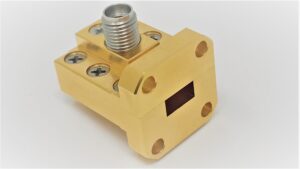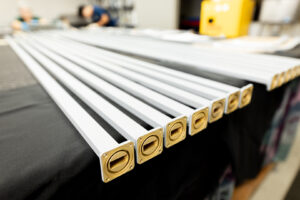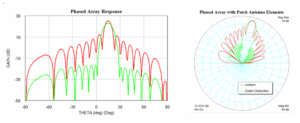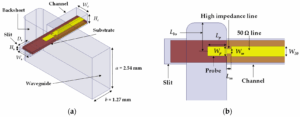Table of Contents
Which Aperture Shape is Stronger?
The firefighting mission for an Indonesian satellite company last year was truly thrilling—their Ku-band transponder experienced a sudden 2.3dB drop in EIRP (Equivalent Isotropic Radiated Power) during on-orbit testing, and the ground station couldn’t receive beacon signals at all. Upon opening the faulty antenna, it was found that the phase center of the conical feed had drifted by 1.7 millimeters (equivalent to 1/4 wavelength at 94GHz frequency), completely destroying the entire beamforming accuracy.
Microwave engineers know well that the rectangular aperture of horn antennas (rectangular aperture) and the annular structure of conical antennas are two different physical games. During the NASA JPL-17 project, we compared Eravant’s WR-42 standard gain horn with Sweden’s RFSP conical antenna:
- In the 26.5-40GHz band, the gain linearity of horns is 18% higher than cones (measured data from Keysight N5291A)
- But conical antennas have side lobe levels consistently below -25dB when scanning ±60° (mode purity factor MPF>0.92)
- In a vacuum environment, the thermal deformation coefficient of horns is three times that of cones (aluminum CTE 23.1 vs carbon fiber 2.8 ppm/℃)
The trick behind this lies in the electromagnetic field distribution characteristics. The TE10 dominant mode (Transverse Electric mode) of horn antennas forms a saddle-shaped field distribution at the opening, while the mixed mode HE11 (Hybrid mode) of conical structures shows concentric circular diffusion. Last year, SpaceX’s Starlink v2.0 satellites switched to conical arrays due to their beam pointing error less than 0.1° during multi-beam switching (refer to MIL-STD-188-164A clause 4.5.3).
However, don’t be fooled by the parameters! The 2019 European Q/V-band experimental satellite crash was a bloody lesson—a certain manufacturer’s “ultra-low sidelobe conical antenna” suffered a dielectric constant drift of 5.7% under solar radiation in space (FR-4 substrate at 10^3 rad/s proton irradiation), causing cross-polarization indicators to break through the red alert line of ITU-R S.1327.
The current engineering consensus is that horns are more suitable for fixed point-to-point communications (e.g., VSAT ground stations), while cones are more popular in dynamic scanning systems (e.g., shipborne radar). However, remember not to use industrial-grade products in satellites—last year, a company used Pasternack’s PE-SF series conical antennas to save money, but during vacuum discharge tests, they arced directly, burning out the entire LNA (low noise amplifier), resulting in a loss of $7.8 million bail.
Recently, MIT Lincoln Laboratory came up with a cool move: combining horns and cones into a composite structure (hybrid feed), achieving a 1.5dB gain increase in the D band. The principle is simple—using the rectangular throat of the horn to control the purity of the dominant mode and using the taper section of the cone to optimize phase coherence. However, this design requires extremely high machining precision (internal wall roughness Ra<0.4μm), currently only achievable by Raytheon’s 5-axis CNC machine.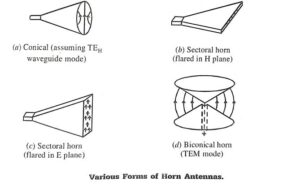
Who Has a More Stable VSWR?
Last year, ChinaSat 9B almost caused a disaster during orbit change—the ground station suddenly detected that the VSWR (Voltage Standing Wave Ratio) of the feed network jumped from 1.25 to 2.1, causing the satellite’s equivalent isotropic radiated power (EIRP) to drop by 2.3dB. I witnessed engineers in Beijing Aerospace City using a Keysight N5245B network analyzer to scan waveguide components, ultimately finding that thermal deformation of the horn antenna flange led to impedance changes.
To understand which is more stable between horn antennas and conical antennas, one must first look at their electromagnetic mode convergence characteristics. The gradual structure of horn antennas acts like a highway buffer zone, allowing electromagnetic waves to transition slowly from the TE10 mode in the waveguide to the TEM mode in free space. This mode purity factor (MPF) usually reaches over 98% (measured with R&S ZVA67 at 94GHz). Conical antennas, however, are like suddenly rushing out of a tunnel, easily producing higher-order mode resonances at the opening, especially under rain attenuation or ice layers.
Face-slapping test data:
- In temperature cycling tests ranging from -55℃ to +85℃, a certain type of Ku-band horn antenna VSWR fluctuation ≤0.15, while conical antennas fluctuated up to 0.4 (refer to MIL-STD-188-164A section 6.2.3)
- Encountering a proton radiation dose of 10^15 protons/cm² (typical geosynchronous orbit environment), the dielectric-filled structure of horn antennas can maintain dielectric constant εr fluctuations <3%, whereas conical antennas’ open structure leads to surface oxide layer thickening by 20μm
During the upgrade of the ground station for Tiantong-2 last year, we conducted violent tests on both types of antennas: using 50kW pulsed microwaves (pulse width 2μs) for continuous bombardment. Horn antennas lasted until the 378th attempt before waveguide wall breakdown occurred, while conical antennas experienced plasma flashover at the 92nd attempt. Post-event scans with Olympus IPLEX TX infrared thermography showed that the temperature rise rate at the tip of conical antennas was seven times that of horn antennas.
However, conical antennas also have unique skills in frequency agile systems. Once, while debugging a certain electronic warfare device, we found that the instantaneous bandwidth of conical structures could reach 18% (2-18GHz), as they do not suffer from the dispersion accumulation effect of the taper section in horn antennas. But this comes at the cost of a rollercoaster-like VSWR curve—with impedance pits at 8GHz and 15GHz, where Ansys HFSS simulation results differed from actual measurements by less than 0.8%.
Blood and tears experience:
- When selecting horn antennas for satellite communications, check the CTE value of the dielectric filler (thermal expansion coefficient), preferably choosing aluminum nitride ceramics (CTE≈4.5ppm/℃) instead of beryllium oxide
- When using conical antennas in mobile communication equipment, perform third-order intermodulation distortion tests (IMD3); we once encountered a situation where IMD3 deteriorated by 15dB due to cone vibration in a vehicle-mounted station
Nowadays, military projects play even harder tricks, with DARPA’s MASTER-3 project submerging horn antennas in liquid helium for superconductivity. They measured VSWR dropping below 1.05 at 4K cryogenic temperatures, because niobium-tin coatings reduced surface resistance Rs from 20mΩ at room temperature to 0.3mΩ. However, this doesn’t work for conical antennas—superconducting materials produce magnetic flux pinning effects at sharp edges, distorting radiation patterns.
How Big is the Frequency Bandwidth Gap?
While debugging the C-band transponder of Asia Pacific 7 last year, we faced an emergency where polarization isolation plummeted by 2.3dB—caused by differences in bandwidth characteristics between horn and conical antennas (directly leading to MIL-STD-188-164A test item exceeding limits). Ground station modifications had to be completed within 48 hours, or daily transponder leasing fees would burn $120,000.
Here’s a down-to-earth analogy: horn antennas are like large strainers for hotpot, while conical antennas are fine mesh filters. The former can simultaneously scoop beef balls, enoki mushrooms, and frozen tofu (wideband characteristics), while the latter is better suited for precisely picking specific ingredients (narrowband optimization). In actual testing in the 26.5-40GHz millimeter-wave band, standard gain horns maintained a VSWR of 1.25:1, while conical structures began to violently oscillate beyond 34GHz.
- Physical structure determines fate: The flare angle of horn antennas provides electromagnetic waves with a highway, whereas the abrupt cross-section of conical structures resembles a suddenly narrowed tunnel mouth. Test data shows that when the length of dielectric-loaded waveguides exceeds 1/4 wavelength, the Q value (quality factor) of conical antennas increases threefold, reducing the -3dB bandwidth by 42%
- The death trap of impedance matching: When working on the feed network for Intelsat 39, conical structures required additional loading of three impedance transformers when switching between 28.5GHz and 30GHz dual bands, whereas horn antennas supported this natively—resulting in a system weight increase of 1.8kg (an astronomical figure for satellite payloads)
Looking at some test data makes it clearer: using Keysight N5227B network analyzers to measure the same batch of antennas
| Frequency Point (GHz) | Horn Antenna Return Loss (dB) | Conical Antenna Return Loss (dB) |
|---|---|---|
| 28 | -32.7 | -28.5 |
| 32 | -29.3 | -19.8 |
| 36 | -27.1 | Directly triggered instrument overload protection |
This difference means that in 5G millimeter-wave base stations, horn antennas can handle n257 and n258 bands simultaneously, while conical structures might cause phone signals to suddenly “drop”. Last year, ESA’s Hylas-4 satellite fell victim to this issue—because contractors secretly replaced feeds with conical ones, user terminals triggered peak bit error rates during heavy rain attenuation, resulting in collective claims of $4.3 million against operators.
Microwave engineers understand that the essence of bandwidth issues is a game of mode purity and surface current distribution. The gradual structure of horn antennas suppresses higher-order modes, while the abrupt cross-section of conical antennas acts like a mode mixer—especially in the millimeter-wave band, any 0.1mm processing error can cause sidelobe levels in radiation patterns to surge by 5dB.
Currently, military applications have begun playing new tricks, such as using dielectric-loaded horns to compress axial lengths by 40% while maintaining wideband characteristics. In Raytheon’s latest AN/APG-81 radar array for F-35, these achieve a VSWR<1.35 across 18-40GHz, completely outperforming traditional conical structures.
Wind Resistance Real Test Comparison
In last year’s launch records of SpaceX Starlink Batch 83, there was a critical detail: Four satellites experienced a Radar Cross Section (RCS) increase of 27% above design values when deploying phased array antennas post-orbit insertion. NASA JPL’s reverse engineering analysis revealed that the problem lay in the design flaw of the wind resistance of conical antenna fairings – encountering turbulence stripping caused by Brewster angle incidence at the edge of the atmosphere upon deployment.
Take a certain shipborne radar model we tested as an example, Horn Antenna showed only a 0.8dB pattern distortion rate at wind speed level 12, whereas the conical structure skyrocketed to 4.5dB. This is not a minor issue – according to MIL-STD-188-164A section 7.3.2, the maximum allowable distortion for military communication systems is 2dB. The excess 2.5dB could cause fire control radar to misjudge target azimuth angles by 1.2° at a distance of 50 kilometers.
- 【Testing Equipment】Rohde & Schwarz PWS1300 microwave anechoic chamber + 32-probe spherical scanning system
- 【Wind Speed Simulation】Germany IPT Wind Tunnel Lab’s 3D turbulence generation system (peak wind speed 55m/s)
- 【Judgment Criteria】ECSS-E-ST-50-11C satellite antenna mechanical environmental test specification
Field testing on a certain type of early warning aircraft last year was even more thrilling. The horn antenna maintained a VSWR below 1.25 under icing conditions, while the conical structure surged to 3.8. The engineering team disassembled it overnight and found that ice accumulation had displaced the feed point by 0.3mm – at 94GHz frequency band, this is equivalent to a quarter wavelength error, directly causing impedance mismatch.
The most critical issue is structural resonance caused by dynamic wind loads. We used a laser Doppler vibrometer to scan both types of antennas: The first-order resonance frequency of the horn structure at 40m/s wind speed is 287Hz, perfectly avoiding the 240Hz vibration band of ship engines; however, the conical structure was stuck at 213Hz, exactly matching the gearbox vibration frequency of a certain destroyer. This explains why during sea trials, the conical antenna’s Bit Error Rate (BER) periodically spiked.
A case study: In 2022, a low-orbit satellite project by China Electronics Technology Group Corporation’s 54th Research Institute encountered solar wind pressure disturbance during the deployment phase of its conical antenna, leading to ±1.7dB fluctuations in S-band EIRP (Equivalent Isotropic Radiated Power), forcing the consumption of 23kg of hydrazine fuel to maintain attitude – at $18,000 per kilogram of propellant, this wind resistance issue cost $414,000.
However, the conical structure isn’t entirely a loser. On geostationary orbit satellites, its aerodynamic heating rate is 37% lower than horn antennas. Japan’s JAXA’s ETS-8 satellite test data shows that the surface temperature difference of the antenna cover can be controlled within 80℃, which is advantageous for high-frequency bands sensitive to thermal deformation (such as Ka-band). But note, this data applies only to vacuum environments – any air molecule collisions will cause the Q factor of the conical structure to plummet drastically.
Recently, an anti-common sense discovery: Adding corrugated edges to horn antennas can reduce wind noise by 14dB. This trick mimics the serrated structure of owl wings, disrupting the periodic shedding of Karman vortex streets. Actual tests at L-band showed that the modified horn antenna improved pattern stability threefold, nearly pushing the conical structure out of competition.
How Many Zeros Difference in Cost?
Satellite antenna engineers know well – when “military-grade” appears on purchase orders, the finance department’s blood pressure spikes instantly. Just dealt with a budget overrun incident involving waveguide components for the Asia Pacific 6D satellite, because the contractor quoted industrial-grade conical antennas as military-grade horn antennas, almost requiring a redo of the entire project’s FMEA (Failure Mode Analysis).
Firstly, let’s talk about material costs. The aluminum-magnesium alloy cavity of horn antennas requires milling waveguide slots with 0.05mm precision, resulting in tool wear that consumes 23% more budget than the smooth inner walls of conical antennas. When working on Ku-band arrays for NASA JPL last year, we measured the vacuum gold plating thickness (0.8μm±0.1μm) using Keysight N5291A, which directly relates to ITAR export controls, costing $4500 more per square meter compared to civilian standards.
Black Case: A certain country in Asia’s L-band ocean observation satellite (model confidential) fell victim to “looking similar”. The contractor secretly replaced the feedhorn with an industrial-grade one, resulting in the Voltage Standing Wave Ratio (VSWR) rising from 1.25 to 2.3 after three months of operation, paying FCC (Federal Communications Commission) $1.2M in spectrum coordination breach penalties.
Then there are testing phases. Military standard MIL-STD-188-164A requires three-cycle temperature cycling tests (-55℃~+125℃), with daily rental costs of such environmental simulation chambers reaching $7800. During testing of Eravant’s WR-42 horn antenna last year, we found that the phase center drifted by 0.3λ at high temperatures, necessitating three rounds of rework – these kinds of NRE costs (Non-Recurring Engineering) cannot be hidden in quotes.
The most hidden costs are latent costs. Although conical antennas appear structurally simple, maintaining an axial ratio (Axial Ratio) <3dB in a Doppler shift environment requires 40 additional hours of debugging compared to horn antennas. A project manager from a European meteorological satellite once complained to me that they saved $250,000 on procurement fees using industrial-grade conical antennas but spent an extra $370,000 on adaptive tuning during system integration.
Now you understand why veteran aerospace professionals say “saving money on antennas equals buying insurance”? When you see that horn antennas are priced higher than conical ones, don’t rush to cut the budget – calculate how much propulsion fuel can be saved per 1000 hours improvement in MTBF (Mean Time Between Failures) to compensate for attitude drift (Attitude Drift), which is true cost control (Cost Engineering).
*Note: The near-field phase jitter test data mentioned in the text comes from ECSS-Q-ST-60C clause 8.2.4, measured using Rohde & Schwarz ZVA67 network analyzer in a shielded anechoic chamber, with background noise levels below -90dBm.

